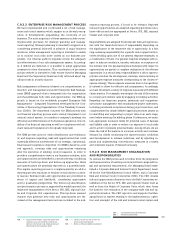Siemens 2012 Annual Report Download - page 206
Download and view the complete annual report
Please find page 206 of the 2012 Siemens annual report below. You can navigate through the pages in the report by either clicking on the pages listed below, or by using the keyword search tool below to find specific information within the annual report.
1 A. To our Shareholders
21 B. Corporate Governance 49 C. Combined Management Report
50 C. Business and economic environment
64 C. Financial performance measures
69 C. Results of operations
82 C. Financial position
93 C. Net assets position
95 C. Overall assessment of the economic position
96 C. Subsequent events
97 C. Sustainability
111 C. Report on expected developments and
associated material opportunities and risks
Infrastructure & Cities is expected to decline year-over-year. We
expect profit at Energy to increase year-over-year despite pro-
gram-related charges, because the basis of comparison in
fiscal includes substantial profit impacts related to large
complex projects and a change in credit risk assessment for
Iran. We expect that Healthcare will increase its profit year-
over-year, despite further charges related to its Agenda
initiative, in part because the Sector will benefit from the ini-
tiative’s productivity measures which have been implemented
from the beginning of fiscal .
Looking ahead to fiscal , we expect all four Sectors to in-
crease their profit compared to fiscal , as part of our inten-
tion to raise our Total Sectors profit margin to at least % by
fiscal . We anticipate that these results will be based most-
ly on the productivity improvements we intend to achieve with
the “Siemens ” program, combined with sharply lower
program-related charges in fiscal compared to fiscal .
As part of One Siemens, we have defined adjusted EBITDA
margin corridors for the respective industries of our four Sec-
tors, which the Sectors seek to achieve and maintain through-
out the complete business cycle. For further information see
. . For Energy the margin
corridor is % to %; for Healthcare the margin corridor is
% to %; for Industry the margin corridor is % to %; and
for Infrastructure & Cities the margin corridor is % to %. De-
spite the substantial charges we expect in fiscal related to
the “Siemens ” program, we expect that only Infrastruc-
ture & Cities will remain below its corridor in fiscal . Based
on anticipated productivity improvements, we expect all four
Sectors to be within their EBITDA corridors by fiscal .
We expect that Equity Investments will result in substantially
lower losses in fiscal compared to fiscal , which was
impacted by charges largely related to the repositioning mea-
sures at NSN mentioned above. We expect these charges to be
substantially lower in the next two years.
In the next two fiscal years, SFS intends to continue to expand
its efforts to meet the growing demand for financial solutions,
particularly with regard to the business-to-business area that
involves both Siemens and external customers. Within One
Siemens, the target range for return on equity or ROE (after
tax) for SFS is % to %. We expect that SFS will continue to
reach this range in both fiscal and . With regard to
profit (defined as income before income taxes), we anticipate
that fiscal profit will be slightly below the level of fiscal
, which included a gain of € million on the sale of an in-
vestment.
We expect that SRE will continue with real estate disposals de-
pending on market conditions, as it has in the past two years.
We expect results from Corporate items and pensions in fiscal
to be approximately a negative € billion.
...
In fiscal , Siemens begins implementation of “Siemens
,” a company-wide program supporting our One Siemens
framework for sustainable value creation. The goal of the pro-
gram is to raise our Total Sectors profit margin to at least %
by fiscal .
In the first year of the program, we expect moderate order
growth and revenue approaching the level of fiscal , both
on an organic basis. We expect income from continuing opera-
tions in the range from €. to €. billion, including the ef-
fect of retrospective adoption of IAS R. This includes charges
totaling approximately €. billion for program-related produc-
tivity measures in the Sectors, with the productivity gains real-
ized in our results for fiscal .
This outlook is based on a number of conditions, notably that
revenue develops as expected particularly for businesses that
are sensitive to short-term changes in the economic environ-
ment. Furthermore, it excludes impacts related to legal and
regulatory matters and significant portfolio effects. Overall,
the actual development for Siemens and its Segments may
vary, positively or negatively from our expectations due to the
risks and opportunities described below. See .. as
well as .. . This report on expected devel-
opments should be read in conjunction with .
- .
.. Risk management
...
Our risk management policy stems from a philosophy of pur-
suing sustainable growth and creating economic value while
avoiding and managing inappropriate risks. As risk manage-
ment is an integral part of how we plan and execute our busi-
ness strategies, our risk management policy is set by the Man-
aging Board. Our organizational and accountability structure
requires each of the respective managements of our Sectors,
SFS, SRE, regional Clusters and Corporate Units to implement
risk management programs that are tailored to their specific
industries and responsibilities, while being consistent with
the overall policy established by the Managing Board.
























